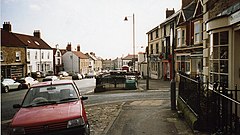Kirby Moorside
| Kirkbymoorside | |
|---|---|
 Kirkbymoorside market place |
|
| Kirkbymoorside shown within North Yorkshire | |
| Population | 3,040 |
| OS grid reference | SE696865 |
| Civil parish |
|
| District | |
| Shire county | |
| Region | |
| Country | England |
| Sovereign state | United Kingdom |
| Post town | YORK |
| Postcode district | YO62 |
| Dialling code | 01751 |
| Police | North Yorkshire |
| Fire | North Yorkshire |
| Ambulance | Yorkshire |
| EU Parliament | Yorkshire and the Humber |
| UK Parliament | |
Kirkbymoorside is a small market town and civil parish in the Ryedale district of North Yorkshire, England, about 25 miles (40.2 km) north of York, midway between Pickering and Helmsley, on the edge of the North York Moors National Park. It has a population of about 3,000, measured in the 2011 Census as 3,040.
Kirkbymoorside is noted as "Chirchebi" in Domesday Book (1086). It has served as a trading hub at least since 1254, when it became a market town. There are two ancient coaching inns extant, the Black Swan with its carved porch, and the cruck-framed George and Dragon, which originated in the 13th century. The Georgian façades point to later periods of commercial prosperity on the coaching route between York and Scarborough.
Some Ancient British, Viking and Anglo-Saxon remains have been found in the vicinity. The Norman baron Robert de Stuteville built a wooden moated castle on Vivers Hill. The estate passed to the Wake family in the 13th century, who brought prosperity to the town. However, it was badly hit by the Black Death of the mid-14th century, after which the wooden castle lay in ruins. Prosperity returned after 1408, when the Neville family took over, although little remains of the fortified manor they built to the north of the town. The Nevilles remained Catholic and took part in the Rising of the North of 1569. By 1660 there was a grammar school. (The building is now part of the library.) The great Toll Booth in the middle of the town was built about 1730 with stone taken from the Nevilles' manor. The old Market Hall was gutted by fire but rebuilt in 1872. By 1881 the population of the town was 2,337.
...
Wikipedia

